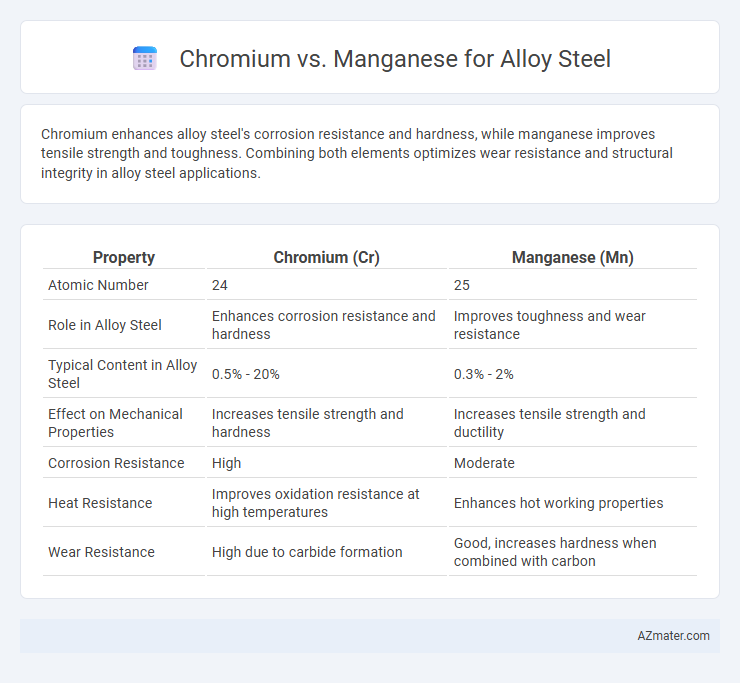Chromium enhances alloy steel's corrosion resistance and hardness, while manganese improves tensile strength and toughness. Combining both elements optimizes wear resistance and structural integrity in alloy steel applications.
Table of Comparison
| Property | Chromium (Cr) | Manganese (Mn) |
|---|---|---|
| Atomic Number | 24 | 25 |
| Role in Alloy Steel | Enhances corrosion resistance and hardness | Improves toughness and wear resistance |
| Typical Content in Alloy Steel | 0.5% - 20% | 0.3% - 2% |
| Effect on Mechanical Properties | Increases tensile strength and hardness | Increases tensile strength and ductility |
| Corrosion Resistance | High | Moderate |
| Heat Resistance | Improves oxidation resistance at high temperatures | Enhances hot working properties |
| Wear Resistance | High due to carbide formation | Good, increases hardness when combined with carbon |
Overview of Alloy Steel and Alloying Elements
Alloy steel enhances mechanical properties by adding elements like chromium and manganese, which significantly improve hardness and corrosion resistance. Chromium increases steel's tensile strength, wear resistance, and oxidation resistance, making it vital for stainless and tool steels. Manganese acts as a deoxidizer and improves toughness and hardness, also enhancing steel's impact resistance and tensile strength under dynamic conditions.
Introduction to Chromium and Manganese
Chromium and manganese are essential alloying elements in steel production, each imparting distinct properties to alloy steel. Chromium enhances corrosion resistance, hardness, and tensile strength, making it crucial for stainless steel and high-performance alloys. Manganese improves toughness, wear resistance, and hardenability while also acting as a deoxidizer and sulfur fixer, which benefits the steel's overall durability and machinability.
Chemical Properties: Chromium vs Manganese
Chromium enhances alloy steel's corrosion resistance and hardness by forming a stable oxide layer, with typical content ranging from 0.5% to 18%. Manganese primarily improves steel's tensile strength and toughness, acting as a deoxidizer and sulfide conditioner at concentrations between 0.3% and 1.5%. Chemically, chromium increases steel's resistance to oxidation and wear, while manganese contributes to improved hot-working properties and resistance to abrasion.
Effects on Mechanical Strength
Chromium enhances alloy steel's mechanical strength by increasing hardness, tensile strength, and wear resistance due to the formation of stable carbides and solid solution strengthening. Manganese improves toughness and ductility while also contributing to strength by removing oxygen and sulfur impurities, which refines the grain structure. Combining chromium and manganese in alloy steel results in a balanced improvement of hardenability, strength, and impact resistance, ideal for high-stress applications.
Impact on Corrosion Resistance
Chromium significantly enhances the corrosion resistance of alloy steel by forming a stable, passive oxide layer that prevents rust and surface degradation. Manganese improves overall toughness and strength but contributes minimally to corrosion resistance compared to chromium. Steel alloys with higher chromium content demonstrate superior durability in harsh, corrosive environments, making chromium a critical element for corrosion-resistant steels.
Influence on Hardness and Wear Resistance
Chromium significantly enhances the hardness and wear resistance of alloy steels by forming hard carbides that increase surface durability and resistance to abrasion. Manganese contributes to hardness primarily through its role as a deoxidizer and by improving the steel's toughness, which helps prevent brittleness under stress. The combined presence of chromium and manganese in alloy steel results in a balanced improvement of hardness and wear resistance, making the steel suitable for demanding applications such as cutting tools and wear-resistant components.
Role in Hardenability and Tempering
Chromium significantly enhances the hardenability of alloy steel by promoting the formation of hard martensitic structures during quenching, which improves strength and wear resistance. Manganese contributes to hardenability as well by stabilizing austenite and improving the steel's toughness and tensile strength while reducing brittleness. During tempering, chromium maintains hardness and improves corrosion resistance, whereas manganese refines grain structure and aids in restoring ductility without compromising strength.
Cost and Availability Differences
Chromium enhances alloy steel strength and corrosion resistance but tends to be more expensive and less abundant than manganese, which is widely available and significantly cheaper. Manganese primarily improves steel hardness and wear resistance, making it a cost-effective choice for large-volume production. The cost difference largely influences alloy composition decisions, with chromium used selectively for high-performance applications due to its premium price and limited supply.
Typical Applications in Alloy Steel
Chromium enhances corrosion resistance and hardness, making it essential in stainless steels and tools subjected to high wear, such as cutting instruments and automotive components. Manganese improves toughness and wear resistance, commonly used in structural steel, railway tracks, and heavy-duty machinery parts. Both elements optimize mechanical properties but target different performance needs in alloy steel applications.
Selecting the Right Element for Specific Steel Grades
Chromium enhances corrosion resistance, hardness, and wear resistance in alloy steel, making it ideal for stainless steel grades and applications requiring high durability. Manganese improves toughness, tensile strength, and deoxidation, benefiting structural and construction steel grades that require enhanced impact resistance. Selecting the right element depends on balancing corrosion resistance with mechanical properties tailored to specific steel grade requirements.

Infographic: Chromium vs Manganese for Alloy Steel
 azmater.com
azmater.com